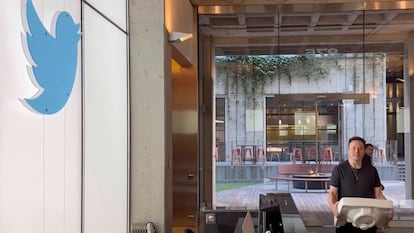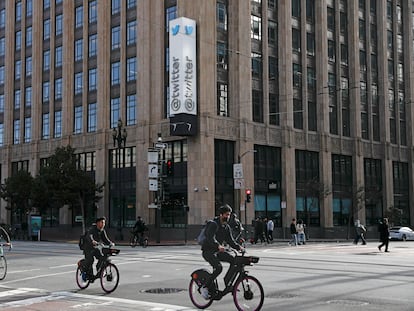Elon Musk’s chaotic first month at Twitter: Layoffs, resignations and lost ad revenue
According to a recent report, the company has lost half of its top 100 advertisers in less than 30 days as one crisis after another plays out in real time


In a way, Elon Musk has lived up to expectations, but he has also surprised everyone with his missteps and hasty decisions. In the month since he bought the company for $44 billion, pandemonium has taken over Twitter. It was a month that brought massive staff layoffs and resignations, poorly executed changes in its content moderation policy, a botched paid subscription offering and the restoration of former President Donald Trump’s account. As Musk biographer Ashlee Vance told EL PAÍS, for the world’s richest man, “… chaos is standard operating procedure.” Musk has certainly proved him right.
It has been a frenetic 30 days since Musk showed up on his first day at Twitter’s headquarters carrying a sink. The richest man in the world tried to back out his deal to buy the company for $54.20 per share, but soon found himself backed into a corner by Twitter’s lawsuit. Musk ultimately agreed to close the deal to avoid a trial that was already proving embarrassing for him.
His first move as owner was to fire CEO Parag Agrawal, CFO Ned Segal, legal and policy chief Vijaya Gadde, and General Counsel Sean Edgett, all of whom received multimillion-dollar severance packages.
“The bird is freed,” declared Musk after closing the acquisition. When Twitter users greeted his arrival with a flurry of racist, anti-Semitic, sexist, homophobic and hate messages, Musk fired off a tweet to reassure advertisers. “Twitter obviously cannot become a free-for-all hellscape, where anything can be said with no consequences! In addition to adhering to the laws of the land, our platform must be warm and welcoming to all, where you can choose the desired experience according to your preferences…,” he wrote in a lengthy tweet in which he said that Twitter aspires to become “the most respected advertising platform in the world.”
But many advertisers were not reassured and according to a recent report, Twitter has lost half of its top 100 advertisers in less than a month. Companies like Chevrolet, Chipotle, Ford, Merck and Novartis openly announced their desertion, while others quietly stopped advertising. Some of the giants that have pulled their advertising from Twitter include American Express, AT&T, Coca-Cola, Citigroup, Wells Fargo, Dell, Diageo, Chanel, Heineken, HP, Meta, Marriott, Nestle and Verizon. Other major advertisers have not pulled out completely but have reduced their Twitter advertising dollars.
The day after closing the acquisition, the South Africa-born billionaire tweeted, “Twitter will be forming a content moderation council with widely diverse viewpoints. No major content decisions or account reinstatements will happen before that council convenes.” Musk quickly broke that promise and retweeted a conspiracy theory about the attack on Paul Pelosi, House Speaker Nancy Pelosi’s husband. He later deleted his tweet.
The first task for the social network’s programmers was to create a subscription model for obtaining a blue “Verified” account badge. On November 1, Twitter announced that it would charge $8 per month for the blue checkmark and early access to select new features. News leaked the following day that Musk was planning to lay off approximately 3,700 employees, half of the company’s workforce, and on November 3, the announcement was made official. “This action is unfortunately necessary to ensure the company’s future success,” the company said. On November 4, as employees began receiving layoff messages, Musk decided to close Twitter’s offices fearing internal sabotage. Musk has brought over software developers and engineers from Tesla and SpaceX to help him manage the changes at Twitter.
A relentless pace
New developments came at a relentless pace. On November 5, Twitter began offering verified account subscriptions for $7.99 a month in the United States, Canada, Australia, New Zealand and the United Kingdom. The initiative was short-lived. Due to the US midterm elections on November 6, Musk decided to defer the launch to avoid a flood of misinformation from verified accounts. He also tweeted on the eve of the elections for voters to back Republican candidates.
Twitter relaunched the subscription service after the elections and havoc broke out. Many of the blue-badged celebrity accounts were actually controlled by impostors. A supposedly verified LeBron James account featured a fake message from the basketball superstar asking to be released from the Los Angeles Lakers. A fake Lockheed Martin account with a blue checkmark announced the defense contractor’s decision to stop arms sales to the US, Israel and Saudi Arabia, causing its stock price to plunge 5%. Pharmaceutical giant Eli Lilly suffered the same fate after another fake Twitter account announced that it would be giving away insulin for free. A message from a “verified” George W. Bush account said he missed “killing Iraqis,” and there was even a “verified” Jesus Christ Twitter account.
To quell the mayhem caused by all the blue-badged impostors, Twitter pulled the plug on account verification. Musk initially said the service would return on November 29, but later pushed it back to December 2. The single blue checkmark certifying account authenticity is gone, and will be replaced by three categories of verified accounts: blue for people, gold for companies, and gray for government accounts. Verified account badges will be manually checked, and will no longer be freely doled out to anyone who pays the fee.
Staff resignations
As if all the public disarray wasn’t enough, the company was roiled by internal turmoil. Musk sent an email ultimatum to all employees asking them to decide by November 17 whether they wanted to be a part of the new Twitter. “This will mean working long hours at high intensity,” he wrote. “Only exceptional performance will constitute a passing grade.” he said. Employees were instructed to accept those terms or leave the company with three-month’s severance pay. Hundreds of employees rejected the ultimatum and opted to leave a workforce already ravaged by layoffs. “The best people are staying, so I’m not super worried,” wrote Musk, although he reportedly tried to convince the company’s engineers and programmers to stay on. Later that night, a message projected on the side of Twitter headquarters in San Francisco read: “Elon Musk: mediocre manchild, pressurized privilege, petty racist, megalomaniac, worthless billionaire, bankruptcy baby, supreme parasite, petulant pimple, apartheid baby.”
As chaos became the norm at Twitter, Musk forgot about his promise to create a moderation council and launched a poll asking if people favored restoring Trump’s Twitter account. The former president had been banned from the platform for inciting the January 6, 2021 Capitol attack by rioters. “The people have spoken. Trump will be reinstated. Vox Populi, Vox Dei,” Musk tweeted, using a Latin phrase meaning “the voice of the people, the voice of God.” Fifteen million Twitter users voted in the poll, and 51.8% favored restoring Trump’s account.
Not long after that, Musk launched a new poll asking users to vote on whether Twitter should offer a general amnesty to suspended accounts, if they have not broken the law or engaged in egregious spam. Only 3.16 million users (less than 1%) voted in that poll, less than 3% of Musk’s own followers. Of these, 72.4% supported the amnesty and 27.6% opposed it. Musk again proclaimed, " The people have spoken. Amnesty begins next week. Vox Populi, Vox Dei.”
Meanwhile, Musk is boasting about breaking records for daily active Twitter users. All of the company’s problems are being furiously debated on its own platform, and the social network is constantly making headlines. And the FIFA World Cup is in progress, always a busy time on Twitter.
On November 25, Musk tweeted that the three-tiered paid verified account model (blue, gold and gray) would be launched on December 2. Thus, Twitter will remain in the headlines for at least another week when the “amnesty” program starts, more details on the new verification system are released, and of course fresh thoughts, quips and tweets from the owner.
Tu suscripción se está usando en otro dispositivo
¿Quieres añadir otro usuario a tu suscripción?
Si continúas leyendo en este dispositivo, no se podrá leer en el otro.
FlechaTu suscripción se está usando en otro dispositivo y solo puedes acceder a EL PAÍS desde un dispositivo a la vez.
Si quieres compartir tu cuenta, cambia tu suscripción a la modalidad Premium, así podrás añadir otro usuario. Cada uno accederá con su propia cuenta de email, lo que os permitirá personalizar vuestra experiencia en EL PAÍS.
¿Tienes una suscripción de empresa? Accede aquí para contratar más cuentas.
En el caso de no saber quién está usando tu cuenta, te recomendamos cambiar tu contraseña aquí.
Si decides continuar compartiendo tu cuenta, este mensaje se mostrará en tu dispositivo y en el de la otra persona que está usando tu cuenta de forma indefinida, afectando a tu experiencia de lectura. Puedes consultar aquí los términos y condiciones de la suscripción digital.
More information
Archived In
Últimas noticias
New York enters the era of Zohran Mamdani
Welcome to the post-religion era: The idea of Christianity as the absolute truth has become obsolete
‘I thought you would like it’: The risky sexual practice popularized by TV shows and TikTok
The digitalization of tourism: ‘They promise experiences and gave us the worst possible one’
Most viewed
- Sinaloa Cartel war is taking its toll on Los Chapitos
- Reinhard Genzel, Nobel laureate in physics: ‘One-minute videos will never give you the truth’
- Oona Chaplin: ‘I told James Cameron that I was living in a treehouse and starting a permaculture project with a friend’
- Why the price of coffee has skyrocketed: from Brazilian plantations to specialty coffee houses
- Silver prices are going crazy: This is what’s fueling the rally









































